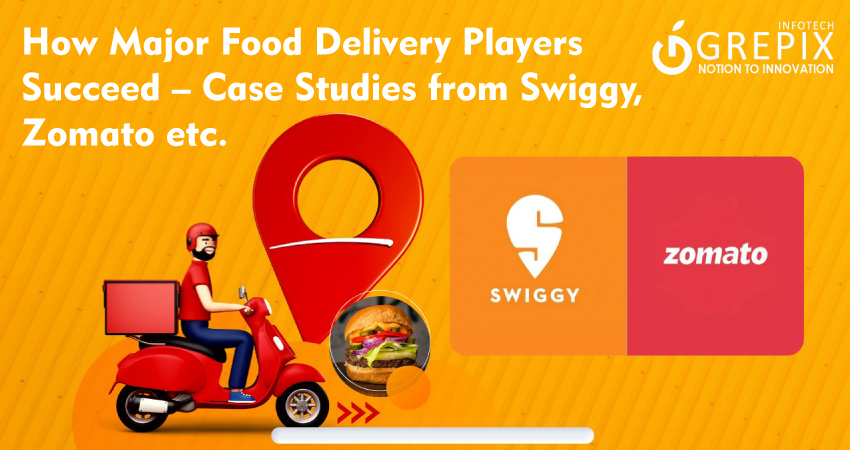How Major Food Delivery Players Succeed & Case Studies from Swiggy, Zomato etc
Over the last decade, food delivery apps like Swiggy, Zomato, and Uber Eats have completely reshaped how urban consumers dine. The global online food delivery market is projected to surpass $490 billion by 2028 driven by digital adoption, time-starved consumers, and competitive pricing.
Among these, India stands out as one of the most dynamic regions, with Swiggy and Zomato leading the race. Their stories offer valuable insights into innovation, business resilience, and digital-first scaling strategies that make them textbook examples of successful food delivery apps.
Food delivery apps have revolutionized the way we eat, blending technology, logistics, and convenience into a seamless experience. In this in-depth food delivery case study, we’ll explore how Swiggy’s success story, Zomato’s business model, and Uber Eats’ innovation-driven scale transformed them into global food-tech leaders. From AI-driven personalization to hyperlocal delivery networks, each platform has redefined customer expectations and restaurant partnerships. This 3,000-word article will dive into funding growth, business strategies, expansion models, and lessons for entrepreneurs aspiring to build successful food delivery apps today.
Swiggy Growth Story: From Local Startup to National Powerhouse
Founding Vision
The Swiggy success story began in 2014 when Sriharsha Majety, Nandan Reddy, and Rahul Jaimini envisioned a platform that could organize India’s fragmented restaurant delivery ecosystem. What started as an idea to solve last-mile inefficiencies quickly spiraled into one of India’s largest digital marketplaces.
Early Challenges and Breakthrough
Initially, Swiggy faced operational losses and struggled with limited city coverage. However, their focus on logistics, technology, and hyperlocal optimization became the key differentiators. By developing a proprietary delivery network, Swiggy ensured control over user experience faster deliveries and real-time tracking.
By 2015, Swiggy handled over 70,000 monthly orders and partnered with 100+ restaurants. Within two years, it expanded to 10 cities and processed 4 million monthly transactions.
Technology and AI Integration
The company’s reliance on AI-driven routing, predictive analytics, and dynamic order assignment elevated logistics efficiency. Swiggy’s system automatically matches riders to nearby orders, minimizing wait times. Furthermore, Generative AI now powers its chat support and personalization algorithms.
Expansion and Diversification
Swiggy expanded from a single city to 500+ cities across India. Strategic launches like Swiggy Access (cloud kitchens) and Instamart (grocery delivery) allowed it to enter adjacent verticals. Through Swiggy Genie, the company began serving as a hyperlocal logistics provider as well.
Investments and Financial Growth
Swiggy raised over $3.6 billion in funding, backed by SoftBank, Naspers, and DST Global. In 2024, its valuation crossed $12 billion, paving the way for a much-anticipated IPO.
Key Takeaways from the Swiggy Case Study
- Build control over logistics early to ensure reliability.
- Use AI and analytics to personalize and optimize delivery.
- Diversify into adjacent services like grocery or cloud kitchens.
- Empower delivery partners through incentives and technology training.
Zomato Business Model: Data, Diversification & Branding
The Evolution of Zomato
Founded in 2008 by Deepinder Goyal, Zomato started as a restaurant discovery platform named Foodiebay. It later evolved into a full-fledged food delivery ecosystem spanning 1,000+ Indian cities.
The All-Rounder Business Model
Zomato follows a multi-sided business model connecting restaurants, customers, and delivery partners. Its revenue model includes:
- Delivery commissions (15–30% per order).
- Advertising and listing fees for restaurants.
- Subscription programs like Zomato Gold/Pro for loyal customers.
- B2B supply services via Zomato Hyperpure.
- Dine-in revenue from restaurant partnerships.
Strategic Expansion Beyond Food
By 2025, Zomato has evolved into a full-stack food-tech and lifestyle brand. The company expanded into grocery delivery, cloud kitchens, and financial services to diversify income streams.
Its Hyperpure initiative supplies restaurants with fresh ingredients creating a vertically integrated ecosystem. The Zomato Pay solution furthers this integration by facilitating app-based dining payments.
Marketing Excellence: Humor & Data
Zomato’s iconic social media and push notification campaigns rely on data-driven targeting combined with witty, brand-consistent messaging. This emotional resonance helped Zomato dominate the online food industry’s marketing landscape.
Zomato’s Competitive Edge
- Strong restaurant partnerships and supply chain control.
- Focused data analytics for user retention.
- Consistent innovation in services (e.g., Zomato Intercity Legends for cross-city deliveries).
- Effective brand storytelling.
Also Read: Accelerating Your Fortune: Becoming a Billionaire in South Africa's Taxi Industry
Uber Eats Case Study: The Global Powerhouse
How Uber Eats Revolutionized Food Delivery
Uber Eats, launched in 2014, leveraged Uber’s existing ride-hailing network to rapidly scale food delivery operations globally. It operates across 45+ countries, serving over 10,000 cities, 900,000+ restaurants, and 120 million monthly users.
Tech-Driven Operations
Uber Eats combines predictive algorithms, traffic-based routing, and real-time GPS tracking to reduce delivery times (average 32 minutes globally in 2025). Its AI-driven backend coordinates between restaurants, drivers, and customers with precision.
Global Impact and Local Adjustments
While Uber Eats standardizes its core systems globally, it localizes marketing, pricing, and partnerships. For example:
- In Japan, Uber Eats focuses on authentic cuisine and local brands.
- In India, it experimented with cloud kitchens before merging with Zomato.
- In the U.S., it launched priority delivery and membership discounts to rival DoorDash.
Lessons from Uber Eats’ Strategy
- Utilize existing infrastructure for faster scaling.
- Integrate AI logistics for real-time optimization.
- Invest in region-specific campaigns and experiences.
- Diversify into on-demand services beyond food.
Key Lessons from These Food Delivery Case Studies
Customer-Centric Innovation
All three companies optimized around user needs—speed, reliability, choice, and transparency. Each used data to predict what customers wanted before they did.
Tech + Logistics Synergy
The secret to a successful food delivery app lies in the marriage of technology and delivery management—real-time tracking, dynamic pricing, and route optimization.
Diversification Beyond Food
Both Swiggy and Zomato entered cloud kitchens, grocery delivery, and subscription programs, turning delivery apps into lifestyle ecosystems.
Data-Driven Personalization
Machine learning drives suggestions, offers, and retention tactics. Swiggy uses AI for matching riders to clusters, while Zomato personalizes restaurant discovery.
Brand Differentiation Through Content
Swiggy builds trust through consistency, Zomato thrives on humor and digital engagement, and Uber Eats shines through convenience and accessibility.
Conclusion
In a world where convenience reigns, Swiggy, Zomato, and Uber Eats have become household names not just for their services, but for how they’ve redefined the digital dining experience. These food delivery case studies show that the success of a delivery app doesn’t come from just connecting restaurants to users; it comes from building ecosystems rooted in technology, trust, and community.
As the market moves toward hyperlocal logistics, voice-based ordering, and AI-driven personalization, the next wave of innovation will evolve from today’s best practices. Startups and entrepreneurs can learn from food delivery apps success stories and Zomato business models the importance of adaptability, consumer empathy, and continuous optimization.
FAQs
1. What makes Swiggy’s business model successful?
Swiggy’s success lies in its logistics-first approach, proprietary delivery network, and AI-enabled operations that ensure fast, reliable deliveries.
2. How does Zomato’s business model differ from Swiggy’s?
Zomato operates as a multi-platform ecosystem offering dining, delivery, and B2B services like Hyperpure, while Swiggy focuses on operational control and hyperlocal delivery expansion.
3. What technologies power Uber Eats’ operations?
Uber Eats uses real-time GPS tracking, AI analytics, and predictive order allocation to maintain a 32-minute global average delivery time.
4. How did food delivery apps grow so rapidly after COVID-19?
They leveraged increased demand for contactless delivery, improved hygiene protocols, and rapid expansion into Tier II & III markets.
5. What are key takeaways for startups from these food delivery case studies?
Focus on data-driven innovation, build logistic efficiency early, diversify revenue streams, and prioritize customer retention through personalization and trust.







